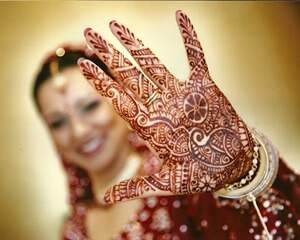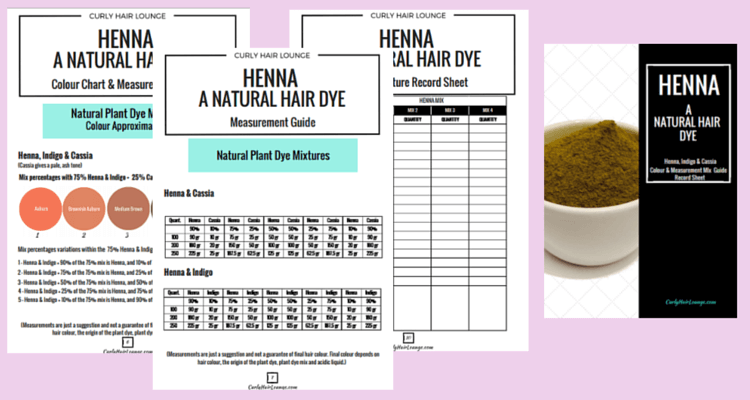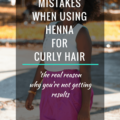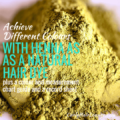Henna is commonly known as a plant dye and my familiarity with it, until a couple of years ago, was limited to a dye used in bridal ceremonies or similar festivities to make beautiful temporary artistic skin designs/tattoos. Today, I know that it is so much more than that. Henna has been used for thousand of years not only to dye skin but also to dye fabrics and leather. However, the most important revelation came when I discovered the uses of henna for hair care.
A lot has been written and said about henna, there is a lot a misconception and wrong beliefs, and in an effort to clear out all this today’s post will have a different tone. As you read through the post you’ll get lots of essential basic information about henna, and specific info for hair care.
If you find you wanna give henna a chance and try dyeing your hair with it, I have just the thing for you. I created a 10-page guide to help you Achieve Different Colours With Henna and get the same results(or better) as me. You can click the image bellow and grab it now for free, but I advise you to read this post first. It will give you further guidance.
What Is Henna?
The use of henna has become popular in western society perhaps due to its increasing curiosity, openness and search for alternative ways of medicine, beauty treatments and spiritual connection to eastern societies. Ayurveda is such an example, dating back to thousands of years and originated in India it focuses on natural healing in which a person can achieve an ideal state of balance between body, mind and soul. Although the use of medical (chemical) prescriptions are not rejected in Ayurveda, it is most known for the use of herbal remedies.
Henna is a popular plant in India and has many medicinal benefits in Ayurveda such as in the treatment of headaches, arthritis, baldness, kidney disease or liver disorder. It also has cooling, astringent, sedative, antibacterial and anti-fungal properties and can be used on the skin to treat eczema, burns or fungal infections and even to lower a high temperature. It can be used in the form of a paste, rinse, oil or internally as a drink to detoxify.
The beauty applications of henna are well known over the world as a body art dye to achieve elaborate designs on the hands and feet for wedding ceremonies and alike. Additionally, henna is also used in hair care to achieve healthy, shiny, and strong hair and has a hair colouring dye.
Lawsonia Inermis, or henna as it is commonly known, is a plant whose leaves produce a red-orange dye widely used in Africa and India. Contrary to some misleading information henna dye can not be obtained from the roots or bark of the plant. This dye can only be obtained from the leaves which have the lawsone molecule responsible for the red-orange colour.

Simple contact with henna leaves will not stain the skin, in order for this to happen you’d need to make a paste or crush them to release the lawsone molecule. Once it gets into contact with the skin’s proteins it will bind to them and release the red-orange dye. However, using dried henna leaves for temporary tattoos and hair care can be difficult, laborious and messy.
Henna powder is an easier option and is commercially available virtually everywhere. The leaves are harvested, dried and powdered and when mixed with an acidic liquid the dye will be released to stain/paint/colour the skin and hair. However, not all henna is the same and its dyeing property varies according to where it was harvested from and its lawsone content.
Henna leaves have a 1% -4% lawsone content, and they can reach maximum potential in tropical climates where temperatures reach between 95˚F and 113˚F (35 – 45˚C), such as in northern Africa and western and southern Asia. Depending on these factors there will be lower to higher degrees of dye content. The henna with low dye concentration will be sold to the hair industry, whereas henna with high dye concentration will be sold to be used on the skin. The latter is known as Body Art Quality (BAQ) Henna and is recommended as a hair dye because it produces a more vibrant rich colour and its thinner powder is easier to rinse out.
Henna For Hair Care
As a hair care product henna has been anciently used in Africa and Asia and is now frequently used in westerns societies to achieve healthy hair and as a natural alternative to chemical hair dyes. Henna improves not only the health of your hair but also its texture. Regular application of henna will make your hair stronger and its nourishing properties will condition the hair making it softer, shiny and healthy and consequently, aiding in hair growth.
Using henna in hair care can help prevent dandruff and scalp itching, treat eczema, protect from UV damage, and its anti-fungal and antibacterial properties help eliminate head lice and ringworm.
There have been claims that henna causes build up, gives unnatural colour, “fries” and coats the hair. However, body art quality henna (BAQ), the one indicated for hair use, does not produce such results. One needs to make sure when buying henna that it’s BAQ. The unwanted effects are the result of commercially sold henna of poor quality, meaning henna mixed with synthetic dyes, metallic salts and other mixes. Often times, less scrupulous companies will try to make a profit by using the roots, twigs and bark, however, lawsone dye molecule can only be produced in high quantities in the henna leave.
Many times the henna mixes these companies make are advertised as blond, brown or black to attract a high number of consumers. But they can only achieve these colours by adding chemicals such as lead, acetate, silver nitrate, copper, or nickel which in turn coat and make the hair feel brittle. Those with chemically treated hair are even more at risk when using these compound hennas. The results can be ruinous as the hair can be “fried” and/or exhibit a green or purple colour.
The lawsone dye present in henna leaves produces only one colour – red-orange. However, this colour ranges in hue depending on where it was harvested and the climate. Hot and arid climates will give you henna leaves with higher lawsone dye content, meaning a more vibrant red-orange colour.
How To Use Henna On The Hair
 Henna can be used as a hair rinse by steeping the powder, or dried leaves, for several hours this helps in conditioning and giving you a silky hair. The other common usage is a henna paste. To make this the BAQ henna needs to be mixed with an acidic liquid such as lemon juice or herbal teas to dissolve the cellulose in the powder and release the lawsone dye. However, henna should not me mixed with boiling water if you want to achieve a deep and vibrant red colour. Otherwise, you will end up with with a washed of orange colour that will fade.
Henna can be used as a hair rinse by steeping the powder, or dried leaves, for several hours this helps in conditioning and giving you a silky hair. The other common usage is a henna paste. To make this the BAQ henna needs to be mixed with an acidic liquid such as lemon juice or herbal teas to dissolve the cellulose in the powder and release the lawsone dye. However, henna should not me mixed with boiling water if you want to achieve a deep and vibrant red colour. Otherwise, you will end up with with a washed of orange colour that will fade.
The consistency of the paste must be similar to mashed potatoes and left to rest overnight to release the dye or, for two hours if in a warm (not hot) place (95˚F/35˚C). After this period, you can successfully make thick henna applications on your hair that will give you a red-orange colour after a 4-hour treatment. Similar to an oxidation process, the final colour will settle and darken into deep orange within three days.
How Henna Works On The Hair
When the henna paste is applied on the hair coating it, the lawsone dye travels from the henna paste into the cortex of the hair where it binds with keratin making your hair thicker, stronger and silkier. It is this bond between the keratin and dye that will make the resulting colour different to every person as each hair has its own unique colour.
Henna dye is actually translucent reflecting a red-orange glow, and when light hits the lawsone dye in the outer layers of the hair it bounces off. Contrary to compound henna, BAQ henna can be used in chemically treated hair (dyed, bleached, highlighted, relaxed, etc) without any risk.
Henna on Natural Or Transitioning Hair
Henna can work wonders on naturally curly hair or transitioning hair. Dryness is one of the main characteristics of curly hair, along with common issues with porosity, breakage and slip ends. Doing henna treatments can help kerb these problems. Here are some of the benefits of using henna.
* Closes the cuticle layers of the hair which will make it smooth and silky.
* Makes your hair shiny because the translucent dye deposited on the hair reflects light and the cuticle layers are closed.
* By bonding with keratin, henna will make your hair stronger and help prevent breakage and split ends.
* By nourishing your hair roots henna will help in hair growth and prevent hair loss.
* It will cover dents and holes on the hair structure which will help improve moisture retention/high porosity hair and decrease hair breakage.
* It will help eliminate any issues with itchiness and dandruff with its anti-fungal and antibacterial properties.
* Henna dye will give your dark tresses beautiful red highlights.
* It will loosen your curl pattern giving you more length because henna deposited on your hair will make it heavier.
Henna As A Hair Dye
This is perhaps the most popular use of henna. The red-orange lawsone dye released on the hair will blend with your unique hair colour and give you a natural look because of its translucence. Henna dye will vary in its red-orange hue from red to copper or auburn, depending on your hair colour. But one thing henna won’t do is dye your hair black, brown, blond or many other colours on commercially available henna.
As previously said, henna dye has only one colour which is red-orange. However, different henna colours can be achieved through the use of a henna-chemical mix or a henna and plant dye mix. A henna-chemical mix is called compound henna and uses metallic salts, chemical dyes and sometimes even para-phenylenediamine (PPD – a chemical that can cause severe allergies) to achieve a variety of colours.
Adverse results to henna use happen because of compound mixes, especially when they are used on chemically treated hair. On the other side, if BAQ henna is used with other dye plants there are no allergic reactions. To achieve different hair colours, henna can be mixed with indigo or woad to achieve a black colour, walnut for brown, saffron for blond, acacia catechu for dark brown and other possible mixes.
Please note that it is not possible to dye a dark hair colour into a lighter tone with henna. For this to happen the hair would need to be stripped/bleached out of its colour. So don’t expect this to happen.
Final Thoughts
As you can see there is much more to henna than the simple skin dye for artistic tattoos. Henna can help treat medical and scalp conditions, can improve the health of your hair while at the same time making its colour richer, more intense and shiny.
There are, nevertheless, a few thing that can deter you from using it. Despite the use of a BAQ henna that is finer and easier to rinse off, the application and removal process can be messy especially in the first couple of times when all is new. Another thing to consider is that henna acts as a mild “texturizer” because it deposits on the hair making it heavier and, therefore, stretching the curl pattern and giving you some hair length and decreasing the number of tangles. Those of you who like the curliness of your curls will have to consider this.
I have used henna a few times (6x so far) and I have to say I am impressed. I have bought a ready made henna mix and have made my own henna mix at home, and out of the two, the latter gave me the best results. Even though henna acts on the hair as a protein treatment and must be followed with a moisturising one, my hair was soft, shiny, the colour was amazing and my few grey hairs were completely covered.
I am glad I didn’t give up on henna the first few times I tried as results didn’t seem to compensate the laborious process. So, I did my own research, made my own mix and I can only say – Hurray!! The benefits of henna far outweigh the work it takes.
If what you read here got you all excited to try henna, then the 10-page guide below – Achieve Different Colours With Henna as a Plant Dye – will help you greatly. However, first, I strongly advise you to read the post that complements it. To have access to the free guide just click the image below.
Have you tried henna before? What were your results?
Featured Image Credit: Ienno_Henna Powder on Flickr (license)








8 thoughts on “Henna For Hair Care”
I learned new info here. I thought henna are for tattoo purposes only.
Glad you learned something new today, henna is a wonderful addition for medicinal, beauty or hair care purposes.
Nice, Although I have known about henna for hair for a long time, a friend of mine used it all the time to get her beautiful red color. I knew it was healthy for hair, I just honestly never took the time to research it in this much depth. Thanks for sharing all this great info. I use a natural color close to mine to cover a little gray at my scalp. Do you have any suggestions for henna that works well on medium blonde hair? Thanks!
Hello Jess, every hair is different and if yo want to make your own mixture you will need to some research. I would advise you to start at the henna for hair website (http://www.hennaforhair.com) you will find a lot of info.
I didn’t have a clue about all the things that henna did and am not surprised that it is used in ayurvedic practice either. Amazing amount of info there as I only thought it was used for skin decoration and a hair dye…an eye opening post indeed!
Warmest Wishes, Amber
Hi Amber, I’m glad you learned something new about hair care.
Hi there, great post, I cannot dowload the guide, what a shame :((((
Hi, Leticia! The link is no longer working because I have taken it away. After doing henna for a couple of years I found that it might not be the best option for keeping hair healthy. I started doing it believing I was avoiding damage from chemical colouring, but when well done and maintained the hair can be healthy with chemical colour. Also, the prep, work and hours it takes to do got to me. ?